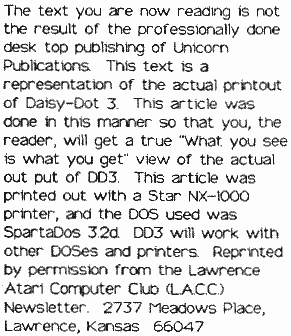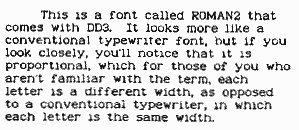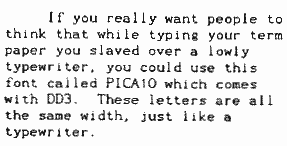

Let me start off by saying what I intend to do with this column. For the moment, I intend to basically talk about Daisy Dot III, from now on refered to as DD3. I'll talk about how to use it and what to expect from it. For starters, DD3 is not a public domain program, it is shareware. DD3's predecessor, DD2, is public domain. I will tell you how to use DD3, and how to get around certain problems. If you have DD2 or get it, I will be happy to talk about that, too, but in doing so, I will talk about the advantages of DD3 over DD2, which is great enough to warrant the purchase of DD3. DD3 is not an expensive program.
What you will get is 2 double-sided single-density disks. On these disks you will get the main program, DD3, and its utilities. These utilities include a customizer program which allows you to customize DD3 so that it boots up with the default settings you specify. You get a utility program that allows you to magnify a font vertically. It allows you to italicize a font. It also allows you to convert any screen character sets into DD3 compatible fonts. You also get a font editor which allows you to modify any DD3 font, or you can create your own from scratch. The font editor also has a customizer program of its own. Also included on the disks are 50 NLQ fonts ready to use.
What's all of this fuss about DD3? Well, let's start off by explaining what it is. DD3 is a "print" processor, as opposed to a "word" processor. What this means is that DD3 takes a word processor file that has been created on a word processor for the 8-bit Atari, and it allows the user to print out that same file with a variety of fonts that otherwise would not be possible for the word processor or that printer. A printout is always limited by the capabilities of the word processor or the printer. If a person knows the control codes of their printer and can enter them into their word processor, they can get a fairly good variety of styles. That variety, however, is not near the variety of styles or the quality of fonts as with DD3.
DD3 allows the printing of what are called NearLetter-Quality fonts, or NLQ. for short. NLQ fonts are fonts that are printed with high enough detail and .resolution that it's hard for a person to tell that it was done on a dot-matrix printer. With NLQ fonts, you can print letters or term papers and people will think that you used a typewriter. With DD3, not only do you have NLQ fonts, but if you don't like the ones you have and want to design your own, you can do so very easily. Also, you can use more than one font in a document. And you're not limited to just the document. If you want, you can even print different fonts on the same printed line! You can underline, italicize or print in different densities. Another thing is that DD3 must do all of the print formatting commands itself. You need your word processor for the sole purpose of entering the text. Any print formatting commands used by your word processor, such as margin changes, line spacing, etc. are not needed. DD3 has its own print formatting commands. You use these instead of your word processor's. While typing in the text using the word processor, simply type in the commands for DD3 where you want the changes. Although they will be part of the text file, they won't take up space when printed.
Is all of this worth the hassle? Well, let's use my printer as an example. I have a Star NX1000 Multifont II printer. It has 4 built-in NLQ styles of letters. It has more if you take into account italics, condensed, bold, and double- and quadruplesized print, but these are just variations of the main four fonts. Other than that, that's it. It is one of the best printers available especially for the price. With DD3, I have 50 more NLQ fonts to chose from which come with the program, plus any other fonts that are either given to me or I make. I am limited only by my imagination. Even my previous printer, a very old and reliable Gemini 10, not a 10X, could print out very nice quality fonts, and it was never intended to print NLQ fonts. This gives the you the ability to print very professional looking documents.
Many of you out there have used the same word processor for years and know how versatile your printouts can be because you have taken the time to know all of the commands of the word processor. The time and effort of learning all of this is well worth it, when you consider the fine results you have had. This is even more true with DD3. With the right commands and fonts, you won't believe some of the things you can do with your tiny 8-bit system. Let me show you just some of the things you can do with DD3:

Keeping that same line of thought you could take it one step further:

Of course, you're not going to fool anyone with these fonts, but they are quite remarkable in their detail. Not many people take the time out to look very closely at every document they see to see what type of method was used to print them. It is quite possible that most people won't give them a second thought, but they'll think you used a typewriter. You might even fool them into thinking that you wrote it by hand:

All of these changes were made with a few keystrokes and a few NLQ font files thrown in. And remember, FIFTY fonts come with the DD3 program. You want a bolder type of printing, say for a flyer or a head line? How about these examples of what you can do with various fonts?

Of the fonts you have seen so far, only ROMAN2, PICA10, and the font you are now reading, called PLAIN, come with DD3. The other fonts I created myself. As far as the NLQ fonts go, they will all be in the public domain. You can feel free to put them on bulletin boards, or download them from bulletin boards. Those extra fonts I have created I have already sent to Roy Goldman, along with many others that I have made. It is not as hard as you think to make new fonts. I will cover that subject in another column.
If you are interested in DD3, and want to get a taste of what it is like, there is a public domain version of DD3 that is free, but it does not do everything that the full-blown version does. The main thing that it doesn't do is it won't allow you to switch fonts in a document. You are stuck with the same font throughout the document. This PD version of DD3 is supposed to be available on the bulletin boards. You might see if you can get it.
You have seen just a few of the samples of what you can do with DD3. Hopefully through this column, I will eventually show you all of the fonts available for DD3 that I am aware of. I hope that I have aroused your curiosity about this excellent program. Eventually we will get into other subjects, such as:
-- Converting Printshop icons so that they are compatible with DD3
-- Double column printing
-- Designing fonts with the font editor, either from scratch or by modifying existing ones
-- Printer compatibility
-- Word processor compatibility
-- Any other subjects you may wish to know about